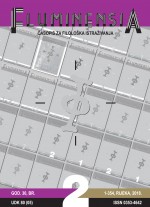TRANSLATION OF MULTINOMIAL EXPRESSIONS: TO WHAT EXTENT ARE DELETIONS ALLOWED?
Keywords:
constituent, corpus, legal system, legal translation, multinomial expression, word stringAbstract
This paper investigates multinomial expressions extracted from the corpus of English contract samples by means of Wordsmith Tools 6.0 (Scott 2012). By analysing the semantic relationship between the constituents of English multinomial expressions, the paper attempts to suggest translation equivalents in Croatian. If constituents are synonymous, motivation for such semantic repetition can be found in history, phonology or genre-related factors. Since these reasons do not apply in the target language, multinomial expressions can be reduced to a lesser number of constituents in Croatian. If multinomial expressions are motivated by other semantic reasons, such as contiguity or hyponymy, it is only rarely that we can omit one of their constituents. This is when we need to study the wider (Sinclair 2004) and the extralinguistic context to find out whether deletions are allowed (Šarčević 1997) or whether we have to retain the same word string in the target language. Results suggest that the language used in English contracts still tends to favour binomials proper (Kopaczyk 2009) despite the centuries-long urging for simplicity in legal language. As a result, we find many instances of doubling, which may be translated by means of single units into Croatian. Other multinomial expressions tend to be motivated by other semantic reasons, such as hyponymy, but, although a hyperonim encompasses the whole semantic field and includes the meaning of other constituents as well, we are not allowed to omit constituents, for they contribute to the all-inclusiveness and preciseness of legal language. Finally, by examining the wider context of these expressions, we can develop the most suitable translation equivalent, since very often it is the wider context that helps us reveal whether the order of constituents may be disrupted or needs to be retained.

